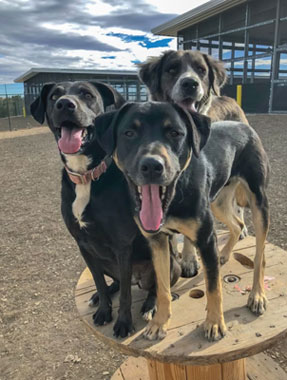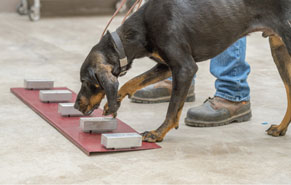Colorado State University, USDA train dogs to sniff out bird flu
Colorado State University and the National Wildlife Research Center are collaborating on a project to train a team of dogs to detect avian influenza in aquatic birds.
"One of the most difficult problems we have in surveillance and detection for diseases in wildlife populations is literally being able to find the disease," said Dr. Tom DeLiberto, assistant director for the NWRC within the U.S. Department of Agriculture's Animal and Plant Health Inspection Service.
In humans, influenza affects large parts of the population, and people are obviously sick, Dr. DeLiberto said. For most wildlife species, especially with influenza, it is often hard to tell whether animals are sick.

"We may only see 20 percent or less of animals infected at any given time, and virtually none of those animals will show any signs that they are infected," he said. "You've got 50 million wild waterfowl on the North American continent in any given year. The test is $50 a sample, and 80 percent or more of those are negative. So our goal is to see if we can develop new tools to help us tell which animals we should test for diseases."

APHIS has a long history of working with detector dogs, and the NWRC is focused on exploring scientific means to reduce human-wildlife conflicts.
"We began this work in 2014, first with mice, then ferrets, and now dogs," said Dr. Richard Bowen, a professor in the Department of Biomedical Sciences and director of the Natural Animal Models Core at CSU College of Veterinary Medicine & Biomedical Sciences, in a press release about the project. "I was skeptical at first and still think it's almost unbelievable, but it keeps working."
Five of the six dogs being trained for the current project came from shelters across the U.S. Dogs are not susceptible to avian influenza.
"The dogs are performing at 97-98 percent accuracy as a group," said Glen Golden, PhD, a research scientist in the Department of Biomedical Sciences at the CSU veterinary college. In mid-February, the dogs were identifying cinnamaldehyde, which gives cinnamon its odor.

The next phase of the project will involve materials from infected and uninfected animals and a number of experiments to challenge the dogs and make sure they are actually identifying materials from infected animals, Dr. Golden said.
However, the dogs are not detecting the virus directly.
"Our current thinking is that infection results in a dramatic metabolic change in the host," said Bruce Kimball, PhD, leader of the NWRC Analytical Chemistry Project. "The volatile profile of feces is a result of the interaction of host with the virus. As yet, we have never identified a unique odorant that only appears in infected animals. The result is up- and downregulation of odorants that are found in the feces of healthy animals. The beauty of using biosensor animals like the mice, ferrets, and dogs is that they are really good at picking up on the subtle differences in these profiles, much better than we can analytically."

If the program is successful, the goal is to deploy dogs in the field across the country.
"We are hoping to deploy them to wildlife biologists and make them a part of the avian influenza surveillance program—and then for these biologists to take these dogs home as a part of the family," Dr. Golden said.
The hope is dogs would allow wildlife specialists to monitor bird flu better and gain more information on how the disease moves.
While the current research focus is avian influenza, the project leaders agree that, if successful, the possibilities could be endless.
"I think if these sets of experiments are effective and we can implement our dogs in the detection of avian influenza, there is a real opportunity with other diseases—to train these dogs on a number of different diseases that are very hard to detect, like chronic wasting disease and Newcastle disease," Dr. DeLiberto said. "There is real potential."
Related JAVMA content:
Inside the headquarters for military dogs (June 1, 2016)
Training a new generation of detection dogs (Nov. 1, 2012)